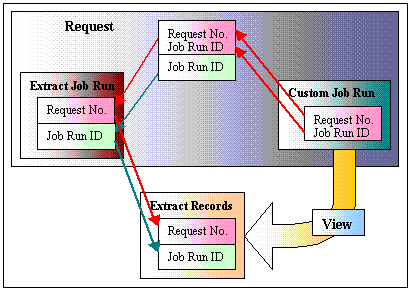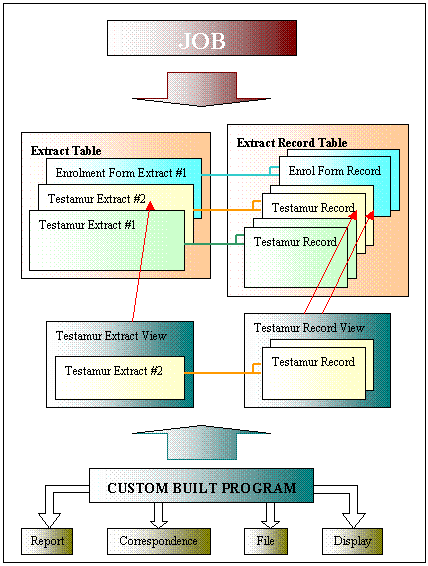Extract Creation Processes
Introduction
A
range of Callista jobs create data extracts as their output. In Callista there
are three major approaches to the production of extracts.
A
number of extract files are created in the Statistics subsystem as part of the government reporting process.
These files are produced from data stored in Callista and are formatted in
accordance with the file format specifications provided by DEST. They are
written to a secure directory, from which the files can be copied and used
in the government statistical package and for analysis by the institution
using an ad-hoc query tool. The Tertiary Admissions Centre statistics process uses a similar approach.
The
second approach to data extract creation involves those jobs which
extract Callista data into specially created extract tables. By writing programs
which access views of the extract tables, individual institutions are able
to customise the content and appearance of files, correspondence, reports
or displays of information produced from the extracted data.
The
third approach is used by some processes in earlier (prior to release 2.0)
releases. In these cases, extract files of pipe delimited text are created.
These files can be accessed by custom programs created by individual institutions.
Other
processes within Callista extract data for immediate use within the process.
The production of admission offer letters takes this approach, extracting
admission application course and unit data for immediate inclusion in a letter.
In these cases the extracted data is not 'stored'.
The
second approach, extraction of data into extract tables, is the subject of
this section. This methodology will eventually be retro-fitted, where appropriate,
to extracts which currently use the third approach, as it simplifies the building
of 'end use' programs by individual institutions.
Extraction of Data Into Extract Tables
Methodology
 Jobs which produce output to extract tables are run through
Job Scheduler
in the usual way. Usually the job will have the Pass
Request Job Run ID indicator set (JBSF4110). This indicates that the unique
reference code which identifies the particular run request/job run instance
is passed as a parameter to the job (and is stored with the output).
Jobs which produce output to extract tables are run through
Job Scheduler
in the usual way. Usually the job will have the Pass
Request Job Run ID indicator set (JBSF4110). This indicates that the unique
reference code which identifies the particular run request/job run instance
is passed as a parameter to the job (and is stored with the output).
This
strategy enables institutions to custom build programs (refer to technical
documentation) which access data in the extract tables and use this data to
produce files, correspondence, reports or displays of information, in the
format of their choosing. A custom program is linked to its extract job by
recording a dependency in JBSF4140. When the custom program and the extract
job are run in the same job request, the custom program uses its Job Run ID
to determine the Request Number of the request in which it is being run. It
then locates the Job Run ID of the most recent extract job run in that request.
Extract records with the appropriate Job Run ID are then presented by the
view.

Extract Jobs
Only
specific jobs produce output to extract tables. Testamur Extract and Enrolment
Form Extract are two examples.
Data Extract Tables
This
method uses a set of generic tables to hold output from any extract producing
job. For each extract type, specific views have been created to present only
data belonging to that extract type. It is these views which are targeted
by the custom built programs.
Extract Views
The
views which have been created to present data stored in the extract tables
are designed to make the data more accessible. Each view is specific to a
particular extract type (e.g. enrolment form extract, testamur extract).
Data
in the extract tables is stored in a generic format, in fields with generic
names. The main body of information for each record is stored in a single,
generic, pipe delimited string. The views break down this information, presenting
each element of a record in a separate field. In the views, the 'key' fields
are given their natural names, e.g. PERSON_ID, CREATE_DT, AWARD_CD etc. (rather
than the generic names used in the extract tables). The pipe delimited string
from an extract table is split into separate fields, named FIELD1, FIELD2
etc. in the corresponding view. This enables extracts which produce more than
one record type to be accommodated.
Custom Programs
Individual
institutions can custom build programs to use the data presented by extract
views. If required, additional data can be extracted from other Callista tables
by the custom program. Each program relates to a specific extract type. The
institution can determine what type of output their custom program produces.
For example, output from an enrolment form program could be in the form of
a printed report or printed correspondence items, a file for bureau printing
or display for on-line forms.
Jobs Producing Extract Files
- Enrolment Form Extract (ENRJ3161)
- Statement of Account Extract (FINJ6120)
- Reminder Notice Extract (FINJ6121)
- Create Testamur Extract (GRDJ6000)
- Confirmation of Enrolment Notice Extract (ENRJ8500)
- HECS Liability Notice Extract (FINJ6190)
- Sponsor Summary Statement Extract (FINJ6130)
Updated
11 March 2002



